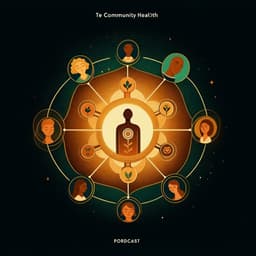
Psychology
Mentalizing, Resilience, and Mental Health Status among Healthcare Workers during the COVID-19 Pandemic: A Cross-Sectional Study
T. Safiye, M. Gutić, et al.
This study conducted by Teodora Safiye and colleagues explores the intriguing connections between mentalizing capacity, resilience, and mental health among 406 healthcare workers during the pandemic. Discover how resilience can mitigate depression and anxiety, highlighting the need to enhance mentalizing abilities in the healthcare sector.
~3 min • Beginner • English
Introduction
The study addresses the impact of the COVID-19 pandemic on the mental health of healthcare workers (HCWs), a group exposed to heightened stressors such as infection risk, long shifts, isolation, and emotional burden. Prior evidence indicates elevated levels of stress, anxiety, depression, and insomnia among HCWs during COVID-19, with sociodemographic and occupational factors (e.g., gender, profession, workplace) influencing outcomes. Resilience—the capacity to adapt and recover from stress—and mentalizing—the ability to understand one’s own and others’ mental states—are posited as protective factors. Mentalizing impairments include hypomentalizing (uncertainty about mental states) and hypermentalizing (overconfidence in inferences about mental states). The primary objective was to determine whether resilience and mentalizing capacity explain levels of depression, anxiety, and stress among HCWs in Serbia during the pandemic. The authors hypothesized significant associations between resilience and mentalizing impairments with mental health status (depression, anxiety, stress).
Literature Review
The paper situates the research within evidence showing substantial psychological burden on HCWs during COVID-19, including stress, anxiety, depression, sleep problems, and burnout. Sociodemographic and occupational correlates (gender, profession, age, work setting) have been linked to worse mental health. Resilience is described as a dynamic, multifactorial trait/process aiding adaptation, with individual, biological, and environmental determinants, and prior work indicates resilience can be trained and mitigates burnout and distress among HCWs. Mentalizing is introduced as understanding intentions and mental states guiding behavior; impairments involve hypomentalizing and hypermentalizing. Prior studies link poor mentalizing to higher distress, emotion dysregulation, and psychopathology, while better mentalizing relates to well-being and may protect against depression and anxiety. The authors note a gap in occupational samples of HCWs examining mentalizing specifically as a protective factor during COVID-19.
Methodology
Design: Cross-sectional study conducted as part of a larger self-funded project ("Burnout syndrome and indicators of mental health of workers during the COVID-19 pandemic in Serbia"). Ethics approval was obtained from the Institutional Review Board, University of Belgrade, Faculty of Philosophy, Department of Psychology (#2021-58). Written informed consent was obtained; anonymity and confidentiality were ensured. Data collection followed the Declaration of Helsinki.
Setting and Participants: Doctors and nurses actively caring for patients at the University Clinical Center Kragujevac (Serbia), living in Serbia, aged 18–65. Data collection via paper-and-pencil surveys from 15 July 2021 to 5 February 2022, during a peak COVID-19 period in Serbia. Sample size estimation using Raosoft indicated 377 required (5% margin of error, 95% CI, population 20,000). Final analyzed sample: N=406 HCWs (141 doctors, 265 nurses), aged 19–65 (M=40.11, SD=9.41).
Measures:
- Mental health status: Depression Anxiety Stress Scales, DASS-42. Three subscales (depression, anxiety, stress), 14 items each, scored 0–3 per item; subscale totals range 0–42; respondents rated symptoms in the previous 7 days. Prior reliability: α>0.8.
- Resilience: Brief Resilience Scale (BRS), 6 items (3 direct, 3 reverse-scored), 5-point Likert (1–5); final score is the mean. Prior reliability: α>0.8.
- Mentalizing capacity: Reflective Functioning Questionnaire, short form RFQ-8 with two subscales: certainty about mental states (RFQ-c; high scores indicate hypermentalizing) and uncertainty about mental states (RFQ-u; high scores indicate hypomentalizing). Items rated 1–7; scoring yields 0–3 per item; higher RFQ-u indicates hypomentalizing; lower scores indicate optimal mentalizing. Prior reliability: α≥0.70.
- Sociodemographic/Work/COVID-19 variables: gender (1=male, 2=female), age, profession (1=doctors, 2=nurses), work environment during COVID-19 (1=frontline, 2=non-frontline), socioeconomic status (1=very poor to 5=excellent), marital status (1=married, 2=single), number of children (1=none, 2=one, 3=two or more). A project-specific questionnaire captured these.
Statistical Analysis: Data screened for incomplete or ineligible responses. Analyses conducted in SPSS 22. Descriptives reported (N, %, mean, SD, min, max, skewness, kurtosis). Internal consistency via Cronbach’s alpha. Pearson correlations assessed associations among variables. Multiple hierarchical linear regressions tested whether resilience (BRS) and mentalizing (RFQ-c, RFQ-u) predicted DASS-42 depression, anxiety, and stress, controlling for gender, age, marital status, number of children, profession, socioeconomic status, and work environment. Assumptions checked (normality, linearity, homoscedasticity, multicollinearity); VIF<5 for all predictors; Durbin-Watson: depression 2.14, anxiety 2.16, stress 2.02.
Key Findings
Sample characteristics: 65.8% female; 65.3% nurses; 50% frontline HCWs. Most rated socioeconomic status as good (56.4%). Scale reliabilities were satisfactory to excellent (e.g., DASS-42 subscales α≈0.93–0.96; RFQ-c α=0.82; RFQ-u α=0.70; BRS α=0.76). Distributions were approximately normal.
Correlations:
- Resilience was negatively correlated with depression (r=−0.51, p<0.01), anxiety (r=−0.51, p<0.05), and stress (r=−0.53, p<0.01).
- Hypermentalizing (RFQ-c) was negatively correlated with depression (r=−0.42, p<0.01), anxiety (r=−0.43, p<0.01), and stress (r=−0.49, p<0.01).
- Hypomentalizing (RFQ-u) was positively correlated with depression (r=0.40, p<0.01), anxiety (r=0.46, p<0.01), and stress (r=0.53, p<0.01).
- Females reported higher depression (r=0.13, p<0.01), anxiety (r=0.25, p<0.01), and stress (r=0.17, p<0.01) and lower resilience (r=−0.18, p<0.01). Older age and more children correlated with lower stress; nurses had higher depression, anxiety, and stress than doctors; frontline HCWs had higher distress than non-frontline.
Hierarchical regression:
- Depression: Adjusted R2 increased from 0.08 (controls) to 0.37 with predictors. Significant predictors: higher resilience (β=−0.37, p<0.01), higher hypermentalizing (β=−0.16, p<0.05) associated with lower depression; higher hypomentalizing (β=0.18, p<0.05) associated with higher depression. Higher socioeconomic status predicted lower depression (β=−0.17, p<0.01).
- Anxiety: Adjusted R2 increased from ~0.10 to ~0.41. Significant predictors: higher resilience (β=−0.35, p<0.01) and hypermentalizing (β=−0.17, p<0.01) predicted lower anxiety; higher hypomentalizing predicted higher anxiety (β=0.22, p<0.01). Nurses had higher anxiety than doctors (β=0.10, p<0.05). Higher socioeconomic status predicted lower anxiety (β=−0.09, p<0.05).
- Stress: Adjusted R2 increased from ~0.06 to ~0.43. Significant predictors: higher resilience (β=−0.40, p<0.01) and hypermentalizing (β=−0.15, p<0.01) predicted lower stress; higher hypomentalizing predicted higher stress (β=0.26, p<0.01). Higher socioeconomic status predicted lower stress (β=−0.08, p<0.05).
In control-only models, older age predicted lower anxiety (β=−0.14, p<0.01) and stress (β=−0.11, p<0.05); female gender predicted higher anxiety (β=0.12, p<0.05) and stress (β=0.11, p<0.05), but age and gender ceased to be significant when resilience and mentalizing were included. Marital status, number of children, and work environment were not significant predictors in full models.
Discussion
Findings support the hypothesis that resilience and mentalizing capacities are key correlates of mental health among HCWs during COVID-19. Greater resilience consistently related to and predicted lower depression, anxiety, and stress, aligning with prior evidence of resilience as a protective factor and as a modulator of burnout and well-being in HCWs. Mentalizing impairments had differential effects: hypomentalizing (uncertainty about mental states) was associated with more depression, anxiety, and stress, while higher scores on hypermentalizing (greater certainty about mental state inferences, as operationalized by RFQ-c) were associated with less distress across outcomes. The results suggest that the capacity to understand and interpret mental states may buffer the psychological impact of pandemic-related stressors in healthcare settings. Profession-specific differences were observed for anxiety (nurses higher than doctors), and socioeconomic status consistently emerged as protective. Age- and gender-related effects on anxiety and stress diminished when accounting for resilience and mentalizing, indicating these psychological capacities may mediate or overshadow demographic effects. Overall, enhancing resilience and mentalizing may improve HCWs’ capacity to manage stressors, interpersonal challenges, and emotional demands, thereby protecting mental health during prolonged crises.
Conclusion
Resilience and mentalizing capacities are crucial for mitigating psychological distress among healthcare workers during the COVID-19 pandemic. Specifically, higher resilience and greater certainty about mental states (hypermentalizing as measured by RFQ-c) predicted lower depression, anxiety, and stress, whereas hypomentalizing predicted higher distress across domains. Socioeconomic status also played a protective role. The study underscores the need to implement strategies and interventions that foster resilience and enhance mentalizing among HCWs to alleviate the pandemic’s mental health impact. Future research should further investigate COVID-19-related and occupational factors influencing mental health and evaluate the effectiveness of resilience- and mentalizing-focused interventions in diverse healthcare settings.
Limitations
- Cross-sectional design limits causal inference and does not rule out reverse causation.
- Single-center sample (one tertiary hospital in Serbia) limits generalizability to all healthcare workers.
- Self-reported measures may be subject to response and reporting biases.
Related Publications
Explore these studies to deepen your understanding of the subject.







